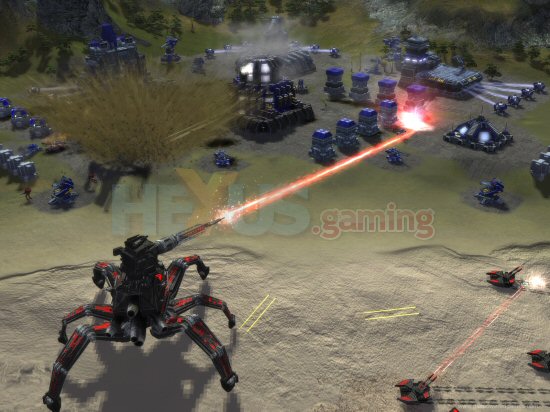Slow start that grows in intensity
Make no bones about it, Supreme Commander begins slowly. The pre-launch hype possibly meant that we were expecting something more exciting from the outset, but as the game progresses and the missions become increasingly difficult the action takes a dramatic turn, the game opens up and the ambitious nature of the game is revealed; Supreme Commander does eventually make you feel as if you are part of a huge scale war. We went from sitting back in our chairs wondering what all the fuss is about to leaning into the screen, tongue poking out, trying to make spur off the moment tactical decisions on how to attack heavily guarded enemy bases; should we send out spy planes? Or send forward the powerful destroyer ships? Perhaps even a mixture of bombers and attack boats? Or maybe we should concentrate on defending our own base with longer range missile launchers or shield generators? As the game progresses and the action on screen becomes more and more like a huge scale war there are dozens of decisions to make; some are spur of the moment and others you’ll have time to tactically ponder over the best move. The slow start to the game is obviously to allow you to become accustom to the interface and allow you to assess the strengths and weaknesses of your units through experimentation. We made many mistakes in the early stages, such as sending in air bombers on an enemy base when it was guarded heavily by anti-air turrets, but the gradual learning curve, which sees the game building up slowly and leading to a huge crescendo of activity, means that these early stages are an ideal opportunity to get to know your units inside out - because you'll need to.
 Click for larger image
Click for larger imageThere are a diverse range of units on offer which you can build with your CDR and base building becomes extremely important to ensure that you have the necessary resources to build more units after you suffer with heavy losses. In the Aeon faction, you get to build and control aircraft ranging from attack bombers and spy planes to the other end of the scale, with Shockers which deal out considerable amounts of damage and a Flying fortress, which not only houses a Quantam beam generator, but can also carry an entire wing of aircraft. Naval units range from the shard which provides anti-air support to the Silencer submarine which houses an array of serpentine tactical missiles. Close-up, units don’t look particularly impressive, but it’s fairly difficult to play Supreme Commander from the zoomed-in perspective anyhow and we played the majority of the game whilst zoomed out, which allowed us to control multiple units and gave us an overall view of the whole battle zone.
 Click for larger image
Click for larger imageWhilst viewing the whole conflict from the zoomed out position the 3D models are replaced with icons, with triangles representing aircraft and semi-circles representing naval craft. In addition to being able to move across the map and see the positions of enemy bases, the UI allows you to issue orders between units, such as retreat and attack, with little effort. The map is extremely well detailed, with units clearly marked and the ability to hover over an object to view its details, not to mention it comes in extremely handy for assessing the battlefield. For example, we sent out 4 bombers to the Eastern side of the map and left our naval fleet guarding the base, whilst we sent a couple of spy planes to the North of the map. Our four bombers came under attack by anti-air missiles and enemy air-craft took two of them out immediately. So, we pulled back our bombers and sent out a couple of attack boats to provide anti-aircraft support for them and sent out three destroyers to take down the anti-aircraft guns. In the meantime the spy planes up North had spotted four aircraft heading for our base, so it was a frantic rush to build more units whilst directing our bomber planes back to the base to intercept the attack. As the action intensified to a level where our brains nearly exploded with the amount of multi-tasking needed and more enemy bases appeared on the map, it was clear that the map is a vital and well designed tool that makes it as easy as possible for you to control and command your units. Due to the numerous decisions you have to make, often within a few seconds if you’re poorly prepared, Supreme Commander can be quite draining as you try to cope with the intense battles that break out across the map.









